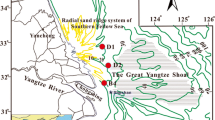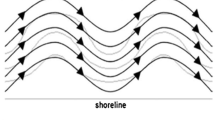Abstract
An instrumented tetrapod was deployed for three weeks on the Dry Tortugas Bank at a depth of 26 m in February 1995. Bottom roughness was dominated by shrimp burrows and worm mounds with rms roughness amplitudes ranging from 0.47 to 1.75 cm. Logarithmic velocity profiles show apparent total roughness heights ranging from 0.30 to 1.45 cm, values consistent with observed biological roughness. The bed sediments were weakly bound by an algal crust at the sediment–water interface. When this bound layer was scraped away by a mooring that was accidentally dragged, sharp-crested wave-induced ripples appeared within the resulting swath. We conclude that physically induced roughness is biologically suppressed, but if dominant, would be significantly higher than the prevailing biological roughness.
Similar content being viewed by others
Author information
Authors and Affiliations
Rights and permissions
About this article
Cite this article
Wright, L., Friedrichs, C. & Hepworth, D. Effects of benthic biology on bottom boundary layer processes, Dry Tortugas Bank, Florida Keys. Geo-Marine Letters 17, 291–298 (1997). https://doi.org/10.1007/s003670050040
Issue Date:
DOI: https://doi.org/10.1007/s003670050040




